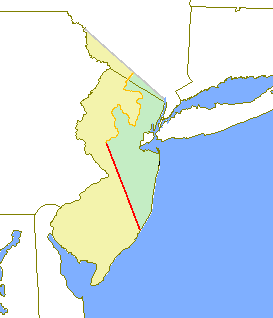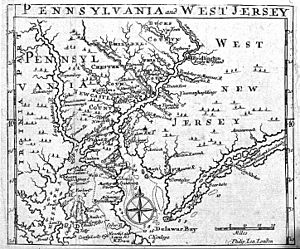West Jersey facts for kids
Quick facts for kids
Province of West Jersey
|
|||||||||||
|---|---|---|---|---|---|---|---|---|---|---|---|
| 1674–1702 | |||||||||||

The original provinces of West and East Jersey are shown in yellow and green respectively. The Keith Line is shown in red, and the Coxe–Barclay Line is shown in orange.
|
|||||||||||
| Status | Colony of England | ||||||||||
| Capital | Burlington | ||||||||||
| Common languages | English | ||||||||||
| Government | Proprietary colony | ||||||||||
| Lords Proprietor | |||||||||||
|
• 1674
|
Edward Byllynge John Fenwick |
||||||||||
| Governor | |||||||||||
|
• 1680-1687
|
Edward Byllynge (first) | ||||||||||
|
• 1699-1702
|
Andrew Hamilton (last) | ||||||||||
| History | |||||||||||
|
• Established
|
1674 | ||||||||||
|
• Disestablished
|
1702 | ||||||||||
| Currency | Pound sterling | ||||||||||
|
|||||||||||
| Today part of | United States | ||||||||||

West Jersey was one of two separate parts of the Province of New Jersey. The other part was East Jersey. These two areas were politically divided for 28 years, from 1674 to 1702. Deciding exactly where the border between West Jersey and East Jersey was located often led to disagreements.
Early History of West Jersey
Before Europeans arrived, the Delaware Valley was home to the Lenape (also known as Delaware) Native Americans. European explorers and settlers, including the Dutch, Swedish, and English, began arriving around 1609. The Dutch West India Company set up a few settlements along the Delaware River. However, by the late 1620s, most of their people moved to Manhattan Island. This island became the main center of their colony, New Netherland.
The colony of New Sweden started in the lower Delaware Valley in 1638. Most Swedish settlers lived on the west side of the Delaware River. The English later rebuilt Fort Nassau to challenge the Swedes. In response, the Swedes built Fort Nya Elfsborg in what is now Salem County. This fort was between modern-day Salem and Alloway Creek. New Sweden also created two main settlements in New Jersey: Sveaborg, now called Swedesboro, and Nya Stockholm, now Bridgeport. Trinity Church in Swedesboro was an important church for the Swedish community.
The Dutch defeated New Sweden in 1655. Not many Europeans settled in the West Jersey area until the English took control in 1664. Starting in the late 1670s, many Quakers moved to this area. They first settled in what is now Salem County. Later, they moved to Burlington, which became the capital of West Jersey.
Border Disputes and Union
Before 1674, land surveyors for New Jersey divided the area into "tenths." West Jersey included five of these tenths. However, drawing the exact borders was difficult. It depended on settlers arriving, paying their land fees (called quit-rents), and the money from these fees being used for surveying. Because of this, it took many years and several surveys to solve arguments over the boundaries. For example, Burlington County was formed on May 17, 1694. It combined the first and second tenths.
Over the years, different lines were drawn to try and define the border between West and East Jersey.
- In 1674, the first line was drawn by the Duke of York.
- In 1676, the Quintipartite Deed created a new line. This line started at 41° 40' latitude on the Delaware River and went south to Little Egg-Harbor.
- Later, in 1687, adjustments were made to this line because of how magnetic compasses worked.
- The "Keith Line" was surveyed in 1687, but it stopped partway.
- In 1688, the "Coxe-Barclay Line" extended the Keith Line. It followed specific properties that now mark the eastern borders of Morris and Sussex Counties. It also defined the northern border of Somerset County.
- Another survey, the "Thornton Line," tried to fix earlier mistakes in 1696.
Despite these efforts, arguments and even violence over the land became very common. Because of these ongoing problems, the owners of East and West Jersey decided to give up their individual governing rights. In 1702, they handed control over to Queen Anne. This act officially united East and West Jersey into one single Province of New Jersey. Even after the union, land ownership disputes continued. The "Lawrence Line Survey" in 1743 was later adopted by the New Jersey Supreme Court in 1855. Today, this line still defines the boundaries for several townships in New Jersey.

